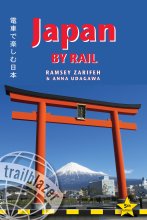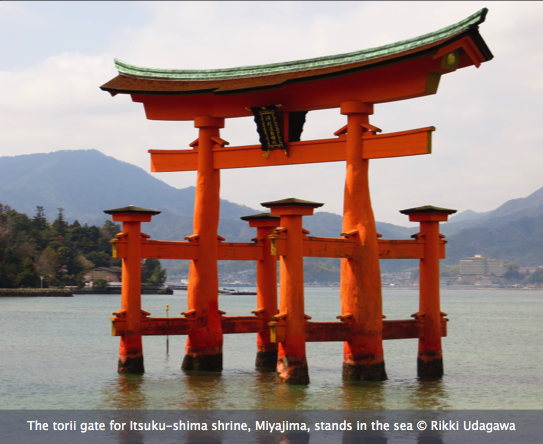I've said it before and I'll say it again, Trailblazer guides take some beating.
— Adventure Travel

Japan by Rail
Excerpt:
Side trip to Miyajima
Contents | Introduction | Routes and costs; When to go | Rail Passes | Sample route guide: Tokyo to Nagoya by shinkansen | Side trip to Miyajima | Off the beaten track sightseeing
Side trips from Hiroshima
Hiroshima is a good base for several side trips. The one that should be on everyone’s itinerary is to Miyajima.
To Miyajima
Famous for its iconic o-torii 大鳥居 (shrine gate) that rises out of the sea, Itsuku-shima Shrine 厳島神社 is considered one of the top three scenic spots in Japan and is the main attraction on the island of Miyajima 宮島; officially called Itsuku-shima 厳島 (Itsuku Island). Other good reasons to make this side trip are the opportunity to hike to the top of Mt Misen (see p310), a free ferry ride if you have a JR Pass or Hiroden Streetcar and Ferry pass, and the chance to visit somewhere that has no traffic lights or convenience stores.
Since Miyajima Island is regarded as an object of worship, childbirth and burial have never been permitted on the island as both are seen as being unclean. Although few think like that now it is still not possible to give birth or be buried here.
From Hiroshima, JR rail-pass holders should take a local train eight stops westbound along the JR Sanyo Line to Miyajima-guchi 宮島口 (2-7/hr; 30 mins). Alternatively, if you have a Hiroden Pass take tram/streetcar No 2 to Hiroden Miyajima-guchi (3-9/hr; 70 mins; ¥260).
At Miyajima-guchi, walk straight down the road from the station to the ferry terminal. From here, JR West ferry services (www.jr-miyajimaferry.co.jp; daily 6am-11pm; 2-4/hr; ¥360 return, free to JR rail-pass holders) take 10 minutes to Miyajima. JR shares the terminal with Matsudai Ferry, which runs an identical service; the Hiroden Streetcar and Ferry Pass (see Getting around, p304) is valid for this ferry.

The tourist information desk 観光案内所 (www.miyajima.or.jp; daily 9am-6pm) inside Miyajima ferry terminal can help book accommodation and also has a tide timetable (useful for working out when to see the torii gate at high and also low tide). There are lockers (¥200-500) outside the ferry terminal. A free shuttle bus 無料送迎バス (3/hr; 10am-5pm) runs to the base of the ropeway (see p310). Aquanet Hiroshima アクアネット広島 (www.aqua-net-h.co.jp) offers a ‘Light up’ cruise (six per evening from about 6pm; 30 mins; ¥1600) from No 3 pier to the O-torii and if the tide is right you can go through the torii gate. Reservations are essential and can be done by email through the website. Another option is to take the train/tram and ferry here and return to Hiroshima by boat on one of Aquanet’s services.
Expect to see deer everywhere when you get off the ferry; you may be chased if you are carrying food. Gluttons for punishment can even pay ¥200 for deer food and watch the ensuing chaos.
According to legend, Itsuku-shima Shrine 厳島神社 (6.30am-5.30/6pm; ¥300) was founded in 593 when three goddesses were led to Miyajima by a crow. It was remodelled in its present structure, with long corridors connecting the main shrine halls, in 1168 and is now a World Heritage Site. Noh performances are occasionally staged at the shrine, which has even seen the occasional fashion show – the 202m-long corridors doubling as the perfect catwalk. Be aware that the route through the shrine is one-way only. The real attraction of the shrine is the o-torii gate rising out of the sea (or, depending on the tide, sticking out of the silt) 200m from the main shrine. At high tide the gate (16m high) appears to float in the water. The first gate here was built in 1168; the current one was constructed in 1875. It is made of camphor wood and covered with vermilion lacquer as that helps protect it from corrosion; the vermilion colour is also believed to keep evil spirits away. It’s worth planning several hours on the island so you have a chance to see the gate at both high and low tide. The o-torii gate is the focal point for the spectacular Miyajima Water Fireworks Festival held offshore here on August 11th (7.40-8.40pm).
The Buddha of Medicine is enshrined in Gojunoto 五重塔, a 5-storied 27m-high pagoda that is easily visible from the shrine. Daisho-in Temple 大聖院, at the bottom of Mt Misen, dates from the 12th century and had close links with the Imperial Family until the 19th century. As you walk up to the temple you pass 500 small statues with unique facial expressions. The temple is also the site of an impressive Fire-Walking Ceremony (Hiwatarishiki) held twice a year (15th Apr & 15th Nov from 11am).
At 530m, Mt Misen 弥山 is the highest peak on Miyajima and there are excellent hiking trails (see below) to its summit as well as a ropeway/cable car ロープウエー (miyajima-ropeway.info/en; daily Mar-Oct 9am-5pm, 8.30am-5.30pm in Golden Week and Obon; Nov 8am-5pm; Dec-Feb 9am-4.30pm; ¥1000/1800 one-way/return; closed for safety checks twice a year, usually for about five days in June & Dec) from Momijidani-koen 紅葉谷公園. It is an easy walk up from Itsuku-shima shrine to the base of the ropeway.
Each of the three main hiking trails takes about 1½-2 hours to the top of Mt Misen; the routes are outlined on a map available from the tourist information desk at the ferry terminal. The Momiji-dani 紅葉谷 (Maple Valley) route is the shortest but steepest; it is lovely at any time of the year but particularly recommended in the autumn. It starts from near the base of the ropeway. The Daisho-in route starts at Daisho-in Temple; it is the least steep route and also offers good views. The other route, the Omoto Route starts from Omoto Shrine 大元神社, which is beyond Itsuku-shima Shrine, but meets the Daisho-in route before you reach the top. The paths are generally easy to follow and not really challenging. However, make sure you stick to them to avoid treading on any snakes and carry water in the summer as it can get very hot.
As you near the top follow signs to Shishi-iwa observatory 獅子岩展望台 (it is near the top of the ropeway) for great views over the Inland Sea. If you are lucky you might also see wild monkeys grooming the deer, especially if the latter are resting. There is a café (open during ropeway hours) under the viewing platform as well as a vending machine. Then head to the summit of Mt Misen.
Even if you take the ropeway (in fact a gondola journey followed by a cable car) you still need to walk for about half an hour to reach the very top of Mt Misen; the path descends first before climbing uphill so don’t worry that you have taken the wrong turn.
If you haven’t hiked all the way up, do consider making the descent on foot. The Momiji-dani route (45-60 mins) takes you through Momiji-dani-koen where there are places to eat and stay. The menu at Momiji-chaya, a café belonging to Momiji-so, includes a variety of udon (¥700) as well as curry rice (¥650); place your order and then sit at one of the tables outside and admire the view. If the thought of leaving this spot is too much a stay at Momiji-so もみぢ荘 (tel 0829-44 0077, www.gambo-ad.com; ¥8640pp room only, ¥17,280pp inc half board) is highly recommended; if booked in advance they will pick you up from the port.
Also in Momiji-dani-koen and with an onsen, is a ryokan called Iwaso 岩惣 (tel 0829-44 2233, www.iwaso.com; from ¥22,680pp for half board and two sharing). The rooms are in a variety of buildings and not all are en suite. Both these places are close to the ropeway/cable car which runs up to Mt Misen.
Watanabe Inn 四季の宿 わたなべ (tel 0829-44 0234, www.auberge-watanabe.com; from ¥17,280pp inc half board) as far as Georgie Tongue is concerned is ‘superb’. The Inn only has four rooms but each has its own cypress wood bath. It is near Daisho-In Temple, about a 30-minute walk from the port.
If you prefer to be by the sea, Miyajima Seaside Hotel 宮島シーサイドホテル (tel 0829-44 0118, www.gambo-ad.com; from ¥12,000pp inc half board) is recommended though it is a little way from the main sights; if requested in advance they can pick you up from the ferry terminal.
Right by the ferry terminal, and a place that also comes highly recommended, is Kinsui Villa 錦水別荘 (toll free in Japan tel 0120-44 2193, tel 0829-44 2191, www.kinsui-villa.jp/en; from ¥15,000pp inc half board). There are some single rooms in the loft but the stairs are steep. Online reservation in Japanese only.
There are plenty of other accommodation options on Miyajima; ask at the tourist information office. However, at peak times (autumn and spring) it is worth booking well in advance.
The cheapest place to stay is back on the mainland at Backpackers Miyajima バックパッカーズ宮島 (tel 0829-56 3650; www.backpackers-miyajima.com; Western-/Japanese-style dorm ¥2900pp). The hostel has cooking facilities, free wi-fi as well as free internet access. Walk down the road from Miyajima-guchi station and keep walking past the ferry terminal. Take the second road to the right and the hostel is on the left.
Japan by Rail
Excerpts:
- Contents
- Introduction
- Routes and costs; When to go
- Rail Passes
- Sample route guide: Tokyo to Nagoya by shinkansen
- Side trip to Miyajima
- Off the beaten track sightseeing
Price: £19.99 buy online now…
Latest tweets